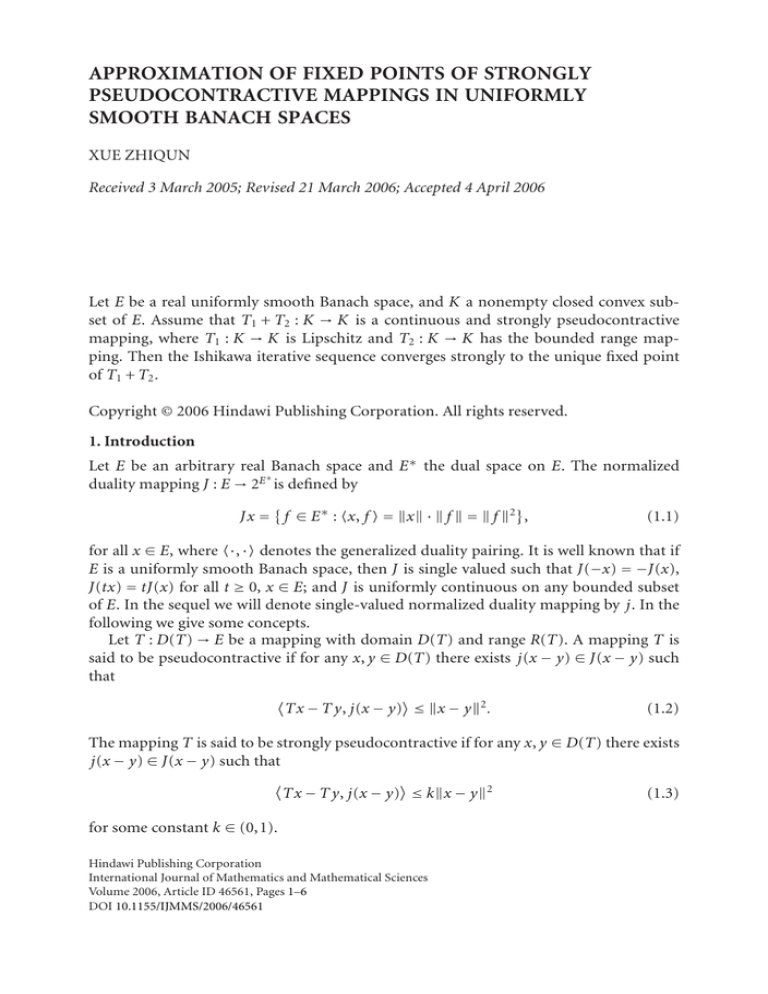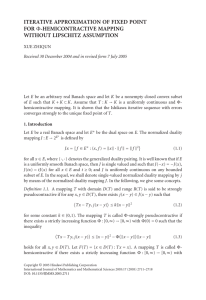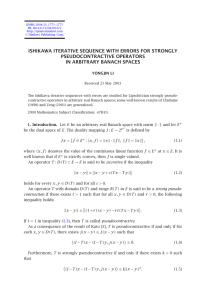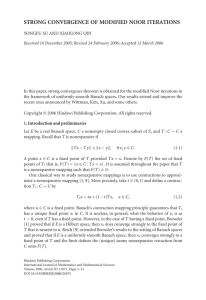
APPROXIMATION OF FIXED POINTS OF STRONGLY
PSEUDOCONTRACTIVE MAPPINGS IN UNIFORMLY
SMOOTH BANACH SPACES
XUE ZHIQUN
Received 3 March 2005; Revised 21 March 2006; Accepted 4 April 2006
Let E be a real uniformly smooth Banach space, and K a nonempty closed convex subset of E. Assume that T1 + T2 : K → K is a continuous and strongly pseudocontractive
mapping, where T1 : K → K is Lipschitz and T2 : K → K has the bounded range mapping. Then the Ishikawa iterative sequence converges strongly to the unique fixed point
of T1 + T2 .
Copyright © 2006 Hindawi Publishing Corporation. All rights reserved.
1. Introduction
Let E be an arbitrary real Banach space and E∗ the dual space on E. The normalized
∗
duality mapping J : E → 2E is defined by
Jx = f ∈ E∗ : x, f = x · f = f 2 ,
(1.1)
for all x ∈ E, where ·, · denotes the generalized duality pairing. It is well known that if
E is a uniformly smooth Banach space, then J is single valued such that J(−x) = −J(x),
J(tx) = tJ(x) for all t ≥ 0, x ∈ E; and J is uniformly continuous on any bounded subset
of E. In the sequel we will denote single-valued normalized duality mapping by j. In the
following we give some concepts.
Let T : D(T) → E be a mapping with domain D(T) and range R(T). A mapping T is
said to be pseudocontractive if for any x, y ∈ D(T) there exists j(x − y) ∈ J(x − y) such
that
Tx − T y, j(x − y) ≤ x − y 2 .
(1.2)
The mapping T is said to be strongly pseudocontractive if for any x, y ∈ D(T) there exists
j(x − y) ∈ J(x − y) such that
Tx − T y, j(x − y) ≤ kx − y 2
for some constant k ∈ (0,1).
Hindawi Publishing Corporation
International Journal of Mathematics and Mathematical Sciences
Volume 2006, Article ID 46561, Pages 1–6
DOI 10.1155/IJMMS/2006/46561
(1.3)
2
Approximation of fixed point mappings in Banach spaces
Recently, Zhou and Jia [5] proved the following result: let E be a real Banach space
with a uniformly convex dual E∗ , and let K be a nonempty closed convex and bounded
subset of E. Assume that T : K → K is a continuous and strong pseudocontraction, the
Ishikawa iteration sequence {xn }∞
n=1 generated by (IS) converges strongly to the unique
fixed point of T. However, when T is continuous strongly pseudocontractive mapping,
one question arises naturally: if T neither is Lipschitzian nor has the bounded range,
whether or not the Ishikawa iterative sequence {xn }∞
n=1 generated converges strongly to
the unique fixed point of T. It is our purpose in this note to solve the above question by
proving the following much more general result: E is a real uniformly smooth Banach
space, and K is a nonempty closed convex subset of E. Assume that T : K → K is a continuous and strong pseudocontraction, and T neither is Lipschizian nor has the bounded
range, then the Ishikawa iteration sequence converges strongly to the unique fixed point
of T.
Lemma 1.1 [5]. Let E be a real Banach space, then for all x, y ∈ E, there exists j(x + y) ∈
J(x + y) such that
x + y 2 ≤ x2 + 2 y, j(x + y) .
(1.4)
Lemma 1.2 [5]. Let {ρn }∞
n=1 be a nonnegative real sequence satisfying
ρn+1 ≤ 1 − λn ρn + σn ,
where λn ∈ [0,1],
∞
n =1 λ n
(1.5)
= ∞ and σn = o(λn ). Then ρn → 0 as n → ∞.
2. Main results
Now we prove the main results of this note, In the sequel, we always assume that E is a
real uniformly smooth Banach space.
Theorem 2.1. Let K be a nonempty closed convex subset of E. Assume that T1 + T2 : K → K
is a continuous and strongly pseudocontractive mapping, where T1 : K → K is Lipschitz and
∞
two real sequences
T2 : K → K has the bounded range mapping. Let {αn }∞
n=1 and {βn }n=1 be
in [0,1] satisfying the following conditions: (i) αn ,βn → 0 as n → ∞; (ii) ∞
n=1 αn = ∞. Then
the Ishikawa iterative sequence generated from an arbitrary x1 ∈ K by (IS1),
xn+1 = 1 − αn xn + αn T1 + T2 yn ,
yn = 1 − βn xn + βn T1 + T2 xn ,
(2.1)
converges strongly to the unique fixed point of T1 + T2 .
Proof. The existence of a fixed point follows from Deimling [4]. Let q be a fixed point of
T1 + T2 . Since T1 + T2 is strongly pseudocontractive, thus for all x, y ∈ K,
T1 + T2 x − T1 + T2 y, J(x − y) ≤ kx − y 2 ,
(2.2)
where k ∈ (0,1). Then we may get that q must be unique fixed point of T1 + T2 . Let L
denote the Lipschitzian constant of T1 , M = supx∈K {T2 x − T2 q}, T = T1 + T2 . Using
Xue Zhiqun 3
(2.1), we have
yn − q ≤ 1 − βn xn − q + βn T1 xn − T1 q + T2 xn − T2 q
≤ 1 − β n x n − q + β n L x n − q + M
≤ 1 − βn + βn L xn − q + βn M.
(2.3)
Set An = J((xn+1 − q)/(1+ xn − q)) − J((yn − q)/(1+ xn − q)), Dn = J((yn − q)/(1 +
xn − q)) − J((xn − q)/(1 + xn − q)), then An → 0, Dn → 0 as n → ∞. Indeed {(yn −
q)/(1 + xn − q)}, {(xn − q)/(1 + xn − q)}, and {(xn+1 − q)/(1 + xn − q)} are all
bounded, using that J is uniformly continuous on bounded subset, hence An → 0 as
n → ∞ and Dn → 0 as n → ∞. Applying Lemma 1.1, we obtain
xn+1 − q2 = 1 − αn xn − q + αn T yn − Tq 2
2
2 ≤ 1 − αn xn − q + 2αn T yn − Tq,J xn+1 − q
2
2 ≤ 1 − αn xn − q + 2αn T yn − Tq,J yn − q
+ 2αn T yn − Tq,J xn+1 − q − J yn − q
2
2
2 ≤ 1 − αn xn − q + 2αn k yn − q
yn − q
xn+1 − q
−J
+ 2αn T yn − Tq,J
1 + xn − q
1 + x n − q × 1 + xn − q
(2.4)
2
2
2 ≤ 1 − αn xn − q + 2αn k yn − q
+ 2αn An L yn − q + M 1 + xn − q).
Again using Lemma 1.1, we obtain
yn − q2 = 1 − βn xn − q +βn Txn − Tq 2
2
2 ≤ 1 − βn xn − q +2βn Txn − Tq,J yn − q
2
2 ≤ 1 − βn xn − q + 2βn Txn − Tq,J yn − q − J xn − q
+ 2βn Txn − Tq,J xn − q
2
2 yn − q
xn − q
−J
xn − q +2βn Txn − Tq,J
≤ 1 − βn
1 + xn − q
1 + xn − q
2
× 1+ xn − q +2kβn xn − q
≤
2
2
1 − βn +2kβn xn − q
+2βn T1 xn − T1 q + T2 xn − T2 q Dn 1+ xn − q
4
Approximation of fixed point mappings in Banach spaces
≤
1 − βn
2
2
+ 2kβn xn − q
+ 2βn Lxn − q + M Dn 1 + xn − q
≤
≤
≤
2
2
2
1 − βn +2kβn xn − q +2βn (L+M) 1+ xn − q
2
2 2
1 − βn +2kβn xn − q +4βn (L +M) 1 + xn − q
2
2
1 − βn +2kβn +4βn (L+M) xn − q +4βn (L+M).
(2.5)
Furthermore, we have the following estimates to a part of (2.4):
2αn An L yn − q + M 1 + xn − q
≤ 2αn LAn 1 − βn + βn L xn − q LMAn βn + MAn 1 + xn − q
2
≤ 2LAn αn 1 − βn + βn L xn − q + 2Mαn An Lβn + 1
+ 2LAn αn 1 − βn + βn L + 2MAn αn Lβn + 1 xn − q
(2.6)
2
≤ (2L + M)An αn 1 + βn L xn − q + (3L + M)An αn 1 + Lβn
2
≤ En xn − q + En ,
where En = (3L + M)An αn (1 + Lβn ). Substituting (2.5) and (2.6) in (2.4), we have
xn+1 − q2 ≤ 1 − αn 2 + 2αn k 1 − βn 2 + 2kβn + 4βn (L + M) + En xn − q2
2
+ 8kαn βn (L + M) + En = 1 − 2(1 − k)αn + Fn xn − q + Gn ,
(2.7)
where Fn = α2n − 4kαn βn + 2kαn βn2 + 4k2 αn βn + 8kαn βn (L + M) + 2kαn En , Gn = 8k(L
+ M)αn βn + En , then Fn = o(αn ), Gn = o(αn ). Hence, we may choose a large positive integer N such that for all n ≥ N,
Fn <
1−k
αn .
2
(2.8)
Thus the above inequality (2.7) yields
xn+1 − q2 ≤ 1 − 3(1 − k) αn xn − q2 + Gn .
2
(2.9)
By Lemma 1.2 we see that as xn − q → 0 as n → ∞. The proof of theorem is completed.
Remark 2.2. Concrete the following example: let E = (−∞,+∞), K = [0,+∞), where
x = |x|, x ∈ E. Let T1 : K → K be defined by T1 x = x/3, and let T2 : K → K be defined
Xue Zhiqun 5
by
⎧ ⎪
⎪
1 − (x − 1)2
⎪
⎪
⎨−
,
if x ∈ [0,1],
⎪
⎪
1
⎪
⎩− ,
if x ∈ (1,+∞).
3
T2 x = ⎪
3
(2.10)
Then T1 is Lipschitz, T2 has the bounded range, and T1 + T2 is strongly pseudocontractive
mapping. But T1 + T2 neither is Lipschitzian nor has a bounded range.
Remark 2.3. Theorem 2.1 contains a good number of the known results as its special
cases. In particular, if the mapping T considered here satisfies one of the following assumptions: (i) T : K → K is a Lipschitzian; (ii) T has the bounded range, then T satisfied
the conditions of Theorem 2.1.
Remark 2.4. In [1], Bogin proved that T is strongly pseudocontractive if and only if (I −
T) is strongly accretive, where I denotes the identity operator. It is well known that if T
is continuous and strongly accretive, then T is surjective, so that, for any given f ∈ E, the
equation Tx = f has unique solution.
Theorem 2.5. Assume that T = T1 + T2 : E → E is a continuous strongly accretive operator,
where T1 : E → E is Lipschitz, T2 : E → E has the bounded range operator. For any given
∞
f ∈ E, define S : E → E by Sx = f − Tx + x for all x ∈ E. Let {αn }∞
n }n=1 be two
n=1 and {β
∞
real sequences [0,1] in satisfying the conditions: (i) αn ,βn → 0 as n → ∞; (ii) n=1 αn = ∞.
Then the Ishikawa iterative sequence generated from an arbitrary x1 ∈ E by (IS2),
xn+1 = 1 − αn xn + αn Syn ,
yn = 1 − βn xn + βn Sxn ,
(2.11)
converges strongly to the unique solution of the equation Tx = f .
Proof. By virtue of Remark 2.3, the equation Tx = f has unique solution. Set S1 x = x −
T1 x, S2 x = −T2 x, x ∈ E. Then S1 is Lipschitz, S2 has the bounded range operator, and
Sx = S1 x + S2 x + f . Hence S is a continuous and strongly pseudocontractive mapping.
We obtain directly the conclusion from Theorem 2.1.
Acknowledgments
The author is highly grateful to the referee for valuable comments and good suggestions
for improving the note. This project is supported by the National Science Foundation of
China and Shijiazhuang Railway College Sciences Foundation.
References
[1] J. Bogin, On strict pseudo-contractions and a fixed point theorem, Technion Preprint MT-29,
Haifa, 1974.
[2] C. E. Chidume, Approximation of fixed points of strongly pseudocontractive mappings, Proceedings
of the American Mathematical Society 120 (1994), no. 2, 545–551.
6
Approximation of fixed point mappings in Banach spaces
[3] C. E. Chidume and M. O. Osilike, Ishikawa iteration process for nonlinear Lipschitz strongly accretive mappings, Journal of Mathematical Analysis and Applications 192 (1995), no. 3, 727–741.
[4] K. Deimling, Zeros of accretive operators, Manuscripta Mathematica 13 (1974), no. 4, 365–374.
[5] H. Zhou and Y. Jia, Approximation of fixed points of strongly pseudocontractive maps without Lipschitz assumption, Proceedings of the American Mathematical Society 125 (1997), no. 6, 1705–
1709.
Xue Zhiqun: Department of Mathematics, Shijiazhuang Railway College,
Shijiazhuang 050043, China
E-mail address: xuezhiqun@126.com






